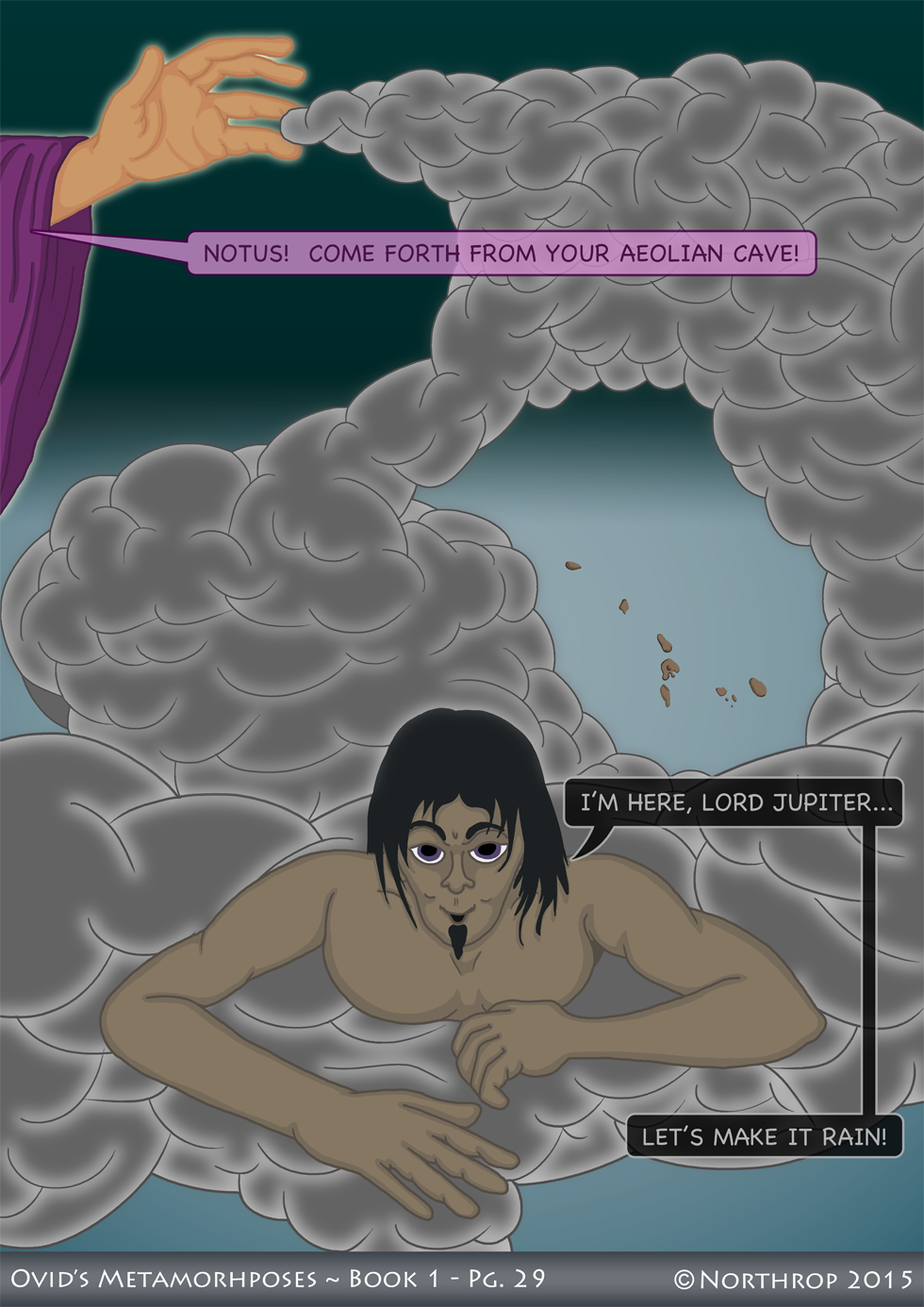Met. 1.262-9 – The Winds Unleashed
PROTINUS AEOLIIS AQUILONEM CLAUDIT IN ANTRIS
ET QUAECUMQUE FUGANT INDUCTAS FLAMINA NUBES
EMITTITQUE NOTUM. MADIDIS NOTUS EVOLAT ALIS
TERRIBILEM PICEA TECTUS CALIGINE VULTUM;
BARBA GRAVIS NIMBIS, CANIS FLUIT UNDA CAPILLIS,
FRONTE SEDENT NEBULAE, RORANT PENNAEQUE SINUSQUE.
UTQUE MANU LATE PENDENTIA NUBILA PRESSIT,
FIT FRIGOR; HINC DENSI FUNDUNTUR AB AETHERE NIMBI.
STRAIGHT AWAY, HE SHUT UP AQUILO, THE NORTH WIND, IN THE AEOLIAN CAVES
AND WHATEVER BREEZES FLEE THE GATHERING CLOUDS
AND SENT OUT NOTUS. NOTUS FLEW OUT ON SOAKED WINGS
HIS TERRIBLE FACE COVERED IN PITCH DARKNESS;
HIS BEARD WAS HEAVY WITH CLOUDS, WATER FLOWED IN HIS WHITE HAIRS,
ON HIS FOREHEAD SAT CLOUDS, AND HIS FEATHERS AND FOLDS DRIPPED.
AND AS HE PRESSED THE LOOMING CLOUDS FAR AND WIDE,
IT GREW COLD; HENCE THE DENSE CLOUDS POURED OUT OF THE AETHER.
Alright! Time for some chaos! The storm’s a-brewin’ and Jupiter is about to release his full fury. For this, he needs the help of Notus, the south wind (remember him from Page 10?), who spreads storms up across the Mediterranean. I’m not a meteorologist, so I am honestly going to have to take Ovid’s word for it that that is in what the south wind does. The winds were thought to be vehicles for weather patterns. If Notus is blowing, you’re in for rain, for instance. In Greek epic, notes Barchiesi, his name is synonmous with “storms”. Hence Jupiter’s appeal to him to help spread his apocalyptic clouds. They all are kept in a cave in the Aeolian Islands (an island chain off the north coast of Sicily – they are those little dots over Notus’ shoulder), under the watch of king Aeolus. The most famous depiction of Aeolus and his cave comes from Vergil, Aeneid 1 (lines 50-86), in a scene in which Juno convinces Aeolus to unleash all his winds and cause a massive storm to destroy the ships of Aeneas bearing Trojan refugees. Ovid, as usual, has to out-do his predecessors. When the Aeolian winds are unleashed in the Metamorphoses, it’s not just a few ships that are sunk: it’s the whole world!
The winds are also often personified (anthropomorphised is the more academic term), given appearances and personalities. These personalities were usually fairly shallow – Zephyr is sweet and mild, Notus a bit scary, and Boreas is downright rough and nasty – but distinct and recognisable. This brings us to a little unfortunate oversight on my part: when I designed the winds back on Page 10, I forgot that Ovid provided this detailed description of Notus here. Therefore, my Notus actually doesn’t look much like his description. I decided that I had to go with the form I’d already given him, so this is what you get. Let’s call it “artistic liscense”; this is how I imagined Notus
based on his personality. I basically wanted him to look like a goth who just got out of the shower. The wetness I tried to convey with his appearance is consistent with Ovid’s description (and is the most important part, in my opinion), but I messed up the colour of his hair and the size of his beard. Apparently, despite everything, Ovid and I still have different interpretations. Hopefully I will have a chance sometime in the future go about correcting these mistakes. You might also notice that I didn’t give him wings: this wasn’t an oversight – even when doing Page 10, I knew winds traditionally had wings – but an artistic decision. Wings are hard to draw and hard to incorporate into comic panels; frankly, I also felt they detracted from the winds’ appearances. So, the winds are wingless. The wings in classical depictions come from a strong association between the winds and flying (for obvious reasons). Modern readers, familiar with Superman and other comicbook characters, are used to characters who fly without wings. Thus, I reasoned the wings were no longer so necessary for the character designs. What do you think? Did I do the right thing, or should I have stayed more true to the classical depictions?


Discussion ¬